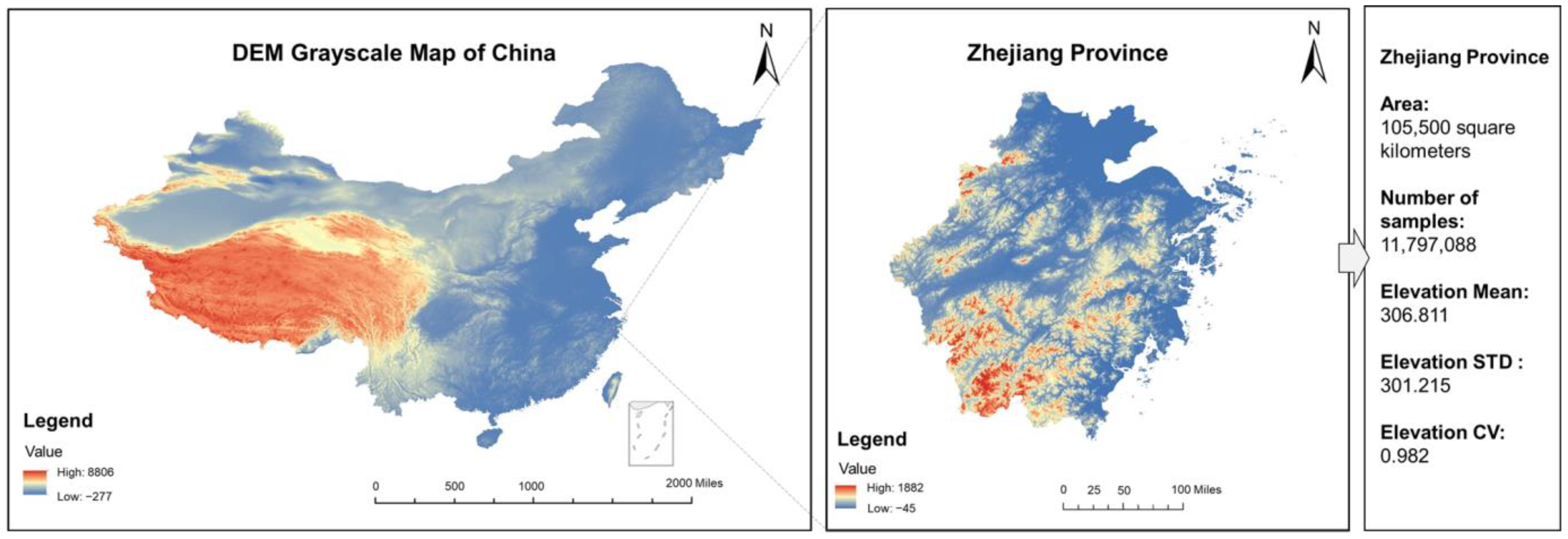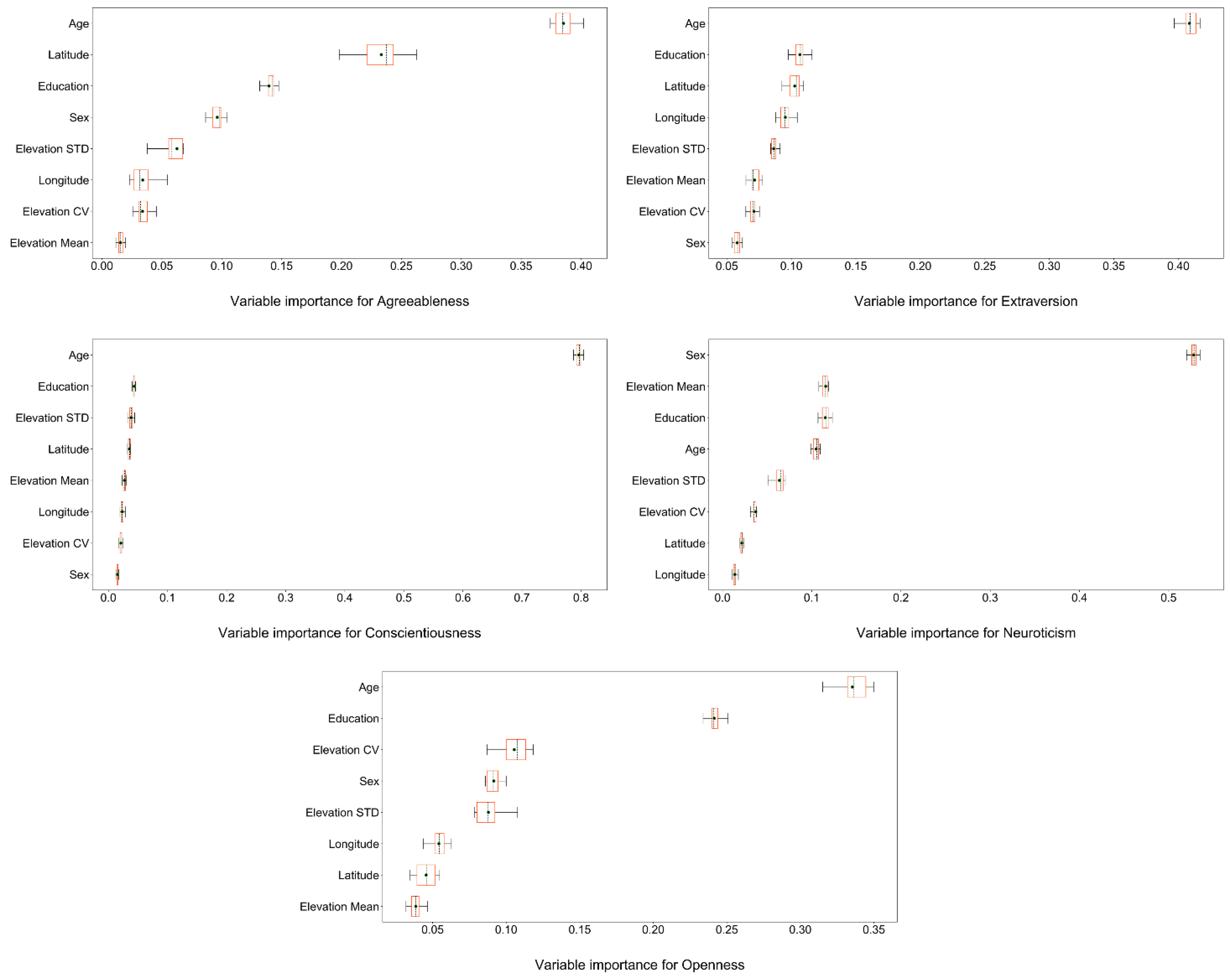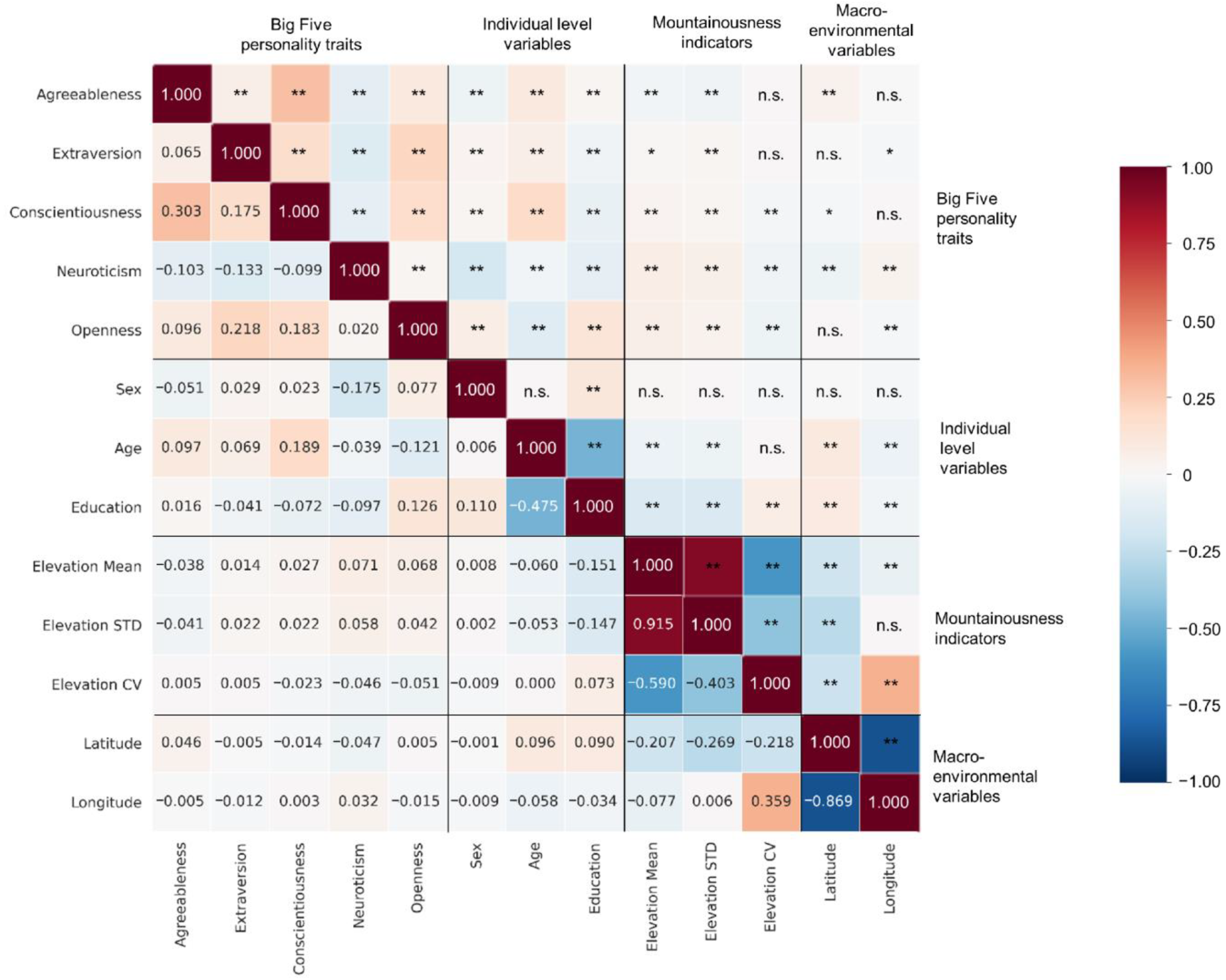Human Personality Is Associated with Geographical Environment in Mainland China
Abstract
:1. Introduction
2. Methods
2.1. Individual Factors
2.2. Mountainousness Indicators
2.3. Data Analysis
2.3.1. Multilevel Modeling
2.3.2. Random Forests Analyses
3. Results
3.1. Distribution of Personality
3.2. Results from Multilevel Modelling
3.3. Results from Random Forests Analyses
4. Discussion
5. Conclusions
Supplementary Materials
Author Contributions
Funding
Institutional Review Board Statement
Informed Consent Statement
Data Availability Statement
Conflicts of Interest
References
- Rentfrow, P.J. Geographical Psychology. Curr. Opin. Psychol. 2020, 32, 165–170. [Google Scholar] [CrossRef]
- Götz, F.M.; Stieger, S.; Gosling, S.D.; Potter, J.; Rentfrow, P.J. Physical Topography Is Associated with Human Personality. Nat. Hum. Behav. 2020, 4, 1135–1144. [Google Scholar] [CrossRef] [PubMed]
- Elleman, L.G.; Condon, D.M.; Russin, S.E.; Revelle, W. The Personality of U.S. States: Stability from 1999 to 2015. J. Res. Pers. 2018, 72, 64–72. [Google Scholar] [CrossRef]
- Rentfrow, P.J.; Gosling, S.D.; Jokela, M.; Stillwell, D.J.; Kosinski, M.; Potter, J. Divided We Stand: Three Psychological Regions of the United States and Their Political, Economic, Social, and Health Correlates. J. Pers. Soc. Psychol. 2013, 105, 996–1012. [Google Scholar] [CrossRef]
- Götz, F.M.; Ebert, T.; Rentfrow, P.J. Regional Cultures and the Psychological Geography of Switzerland: Person–Environment–Fit in Personality Predicts Subjective Wellbeing. Front. Psychol. 2018, 9, 517. [Google Scholar] [CrossRef]
- Allik, J.; Realo, A.; Mõttus, R.; Pullmann, H.; Trifonova, A.; McCrae, R.R.; Yurina, A.A.; Shebanets, E.Y.; Fadina, A.G.; Tikhonova, E.V.; et al. Personality Traits of Russians from the Observer’s Perspective. Eur. J. Pers. 2009, 23, 567–588. [Google Scholar] [CrossRef]
- Jokela, M.; Bleidorn, W.; Lamb, M.E.; Gosling, S.D.; Rentfrow, P.J. Geographically Varying Associations between Personality and Life Satisfaction in the London Metropolitan Area. Proc. Natl. Acad. Sci. USA 2015, 112, 725–730. [Google Scholar] [CrossRef] [PubMed]
- Rentfrow, P.J.; Jokela, M.; Lamb, M.E. Regional Personality Differences in Great Britain. PLoS ONE 2015, 10, e0122245. [Google Scholar] [CrossRef]
- Wei, W.; Lu, J.G.; Galinsky, A.D.; Wu, H.; Gosling, S.D.; Rentfrow, P.J.; Yuan, W.; Zhang, Q.; Guo, Y.; Zhang, M.; et al. Regional Ambient Temperature Is Associated with Human Personality. Nat. Hum. Behav. 2017, 1, 890–895. [Google Scholar] [CrossRef]
- Jokela, M. Personality Predicts Migration within and between U.S. States. J. Res. Pers. 2009, 43, 79–83. [Google Scholar] [CrossRef]
- Kitayama, S.; Conway, L.G.; Pietromonaco, P.R.; Park, H.; Plaut, V.C. Ethos of Independence across Regions in the United States: The Production-Adoption Model of Cultural Change. Am. Psychol. 2010, 65, 559–574. [Google Scholar] [CrossRef]
- Roivainen, E. Personality Adjectives in Twitter Tweets and in the Google Books Corpus. An Analysis of the Facet Structure of the Openness Factor of Personality. Curr. Psychol. 2015, 34, 621–625. [Google Scholar] [CrossRef]
- Ashton, M.C.; Lee, K. Empirical, Theoretical, and Practical Advantages of the HEXACO Model of Personality Structure. Pers. Soc. Psychol. Rev. 2007, 11, 150–166. [Google Scholar] [CrossRef]
- Cattell, R.B. Validation and Intensification of the Sixteen Personality Factor Questionnaire. Read. Clin. Psychol. 1966, 12, 241–254. [Google Scholar]
- Goldberg, L.R. An Alternative “Description of Personality”: The Big-Five Factor Structure. J. Pers. Soc. Psychol. 1990, 59, 1216–1229. [Google Scholar] [CrossRef] [PubMed]
- De Raad, B.; Mlačić, B. The lexical foundation of the Big-Five factor model. In The Oxford Handbook of the Five Factor Model, 1st ed.; Widiger, T.A., Ed.; Oxford University Press: New York, NY, USA, 2017; pp. 191–216. [Google Scholar]
- Caspi, A.; Roberts, B.W.; Shiner, R.L. Personality Development: Stability and Change. Annu. Rev. Psychol. 2005, 56, 453–484. [Google Scholar] [CrossRef]
- Ashton, M.C.; Lee, K.; Paunonen, S.V. What Is the Central Feature of Extraversion? Social Attention versus Reward Sensitivity. J. Pers. Soc. Psychol. 2002, 83, 245–252. [Google Scholar] [CrossRef]
- Buss, D.M. Evolutionary personality psychology. Annu. Rev. Psychol. 1991, 42, 459–491. [Google Scholar] [CrossRef]
- Lucas, R.E.; Diener, E.; Grob, A.; Suh, E.M.; Shao, L. Cross-Cultural Evidence for the Fundamental Features of Extraversion. J. Pers. Soc. Psychol. 2000, 79, 452–468. [Google Scholar] [CrossRef]
- Roberts, B.W.; Jackson, J.J.; Fayard, J.V.; Edmonds, G.; Meints, J. Conscientiousness. In Handbook of Individual Differences in Social Behavior; Leary, M.R., Hoyle, R.H., Eds.; The Guilford Press: New York, NY, USA, 2009; pp. 369–381. [Google Scholar]
- Widiger, T.A. Neuroticism. In Handbook of Individual Differences in Social Behavior; Leary, M.R., Hoyle, R.H., Eds.; The Guilford Press: New York, NY, USA, 2009; pp. 129–146. [Google Scholar]
- McCrae, R.R.; John, O.P. An Introduction to the Five-Factor Model and Its Applications. J. Pers. 1992, 60, 175–215. [Google Scholar] [CrossRef]
- Kitayama, S.; Ishii, K.; Imada, T.; Takemura, K.; Ramaswamy, J. Voluntary Settlement and the Spirit of Independence: Evidence from Japan’s “Northern Frontier”. J. Personal. Soc. Psychol. 2006, 91, 369–384. [Google Scholar] [CrossRef] [PubMed] [Green Version]
- Olsson, O.; Paik, C. Long-Run Cultural Divergence: Evidence from the Neolithic Revolution. J. Dev. Econ. 2016, 122, 197–213. [Google Scholar] [CrossRef]
- Sng, O.; Neuberg, S.L.; Varnum, M.E.W.; Kenrick, D.T. The Behavioral Ecology of Cultural Psychological Variation. Psychol. Rev. 2018, 125, 714–743. [Google Scholar] [CrossRef]
- Oishi, S.; Talhelm, T.; Lee, M. Personality and Geography: Introverts Prefer Mountains. J. Res. Personal. 2015, 58, 55–68. [Google Scholar] [CrossRef]
- Plaut, V.C.; Markus, H.R.; Lachman, M.E. Place Matters: Consensual Features and Regional Variation in American Well-Being and Self. J. Personal. Soc. Psychol. 2002, 83, 160–184. [Google Scholar] [CrossRef]
- Ciani, A.C.; Capiluppi, C. Gene Flow by Selective Emigration as a Possible Cause for Personality Differences between Small Islands and Mainland Populations. Eur. J. Pers. 2011, 25, 53–64. [Google Scholar] [CrossRef]
- Triandis, H.C. Individualism-Collectivism and Personality. J. Personal. 2001, 69, 907–924. [Google Scholar] [CrossRef] [PubMed]
- Dollinger, S.J.; Preston, L.A.; O’Brien, S.P.; DiLalla, D.L. Individuality and Relatedness of the Self: An Autophotographic Study. J. Personal. Soc. Psychol. 1996, 71, 1268–1278. [Google Scholar] [CrossRef]
- Grimm, S.D.; Church, A.T.; Katigbak, M.S.; Reyes, J.A.S. Self-Described Traits, Values, and Moods Associated with Individualism and Collectivism: Testing I-C Theory in an Individualistic (U.S.) and a Collectivistic (Philippine) Culture. J. Cross-Cult. Psychol. 1999, 30, 466–500. [Google Scholar] [CrossRef]
- Moorman, R.H.; Blakely, G.L. Individualism-Collectivism as an Individual Difference Predictor of Organizational Citizenship Behavior. J. Organiz. Behav. 1995, 16, 127–142. [Google Scholar] [CrossRef]
- Kajonius, P.; Mac Giolla, E. Personality Traits across Countries: Support for Similarities Rather than Differences. PLoS ONE 2017, 12, e0179646. [Google Scholar] [CrossRef]
- Church, A.T.; Lonner, W.J. The Cross-Cultural Perspective in the Study of Personality: Rationale and Current Research. J. Cross-Cult. Psychol. 1998, 29, 32–62. [Google Scholar] [CrossRef]
- Steele, L.G.; Lynch, S.M. The Pursuit of Happiness in China: Individualism, Collectivism, and Subjective Well-Being During China’s Economic and Social Transformation. Soc. Indic. Res. 2013, 114, 441–451. [Google Scholar] [CrossRef] [PubMed]
- Zhang, X. Distribution of Mountains and Hills in China. Available online: https://www.osgeo.cn/post/2c1f8 (accessed on 30 July 2022).
- Zhang, H.; An, G.; Zhao, W. The Stereotyped Impression of the Characteristics of Chinese Residences at the Provincial Level from the Perspective of Regional Psychology. J. Longdong Univ. 2010, 21, 113–116. [Google Scholar]
- Schuler, M.; Stucki, E.; Roque, O.; Perlik, M. Mountain Areas in Europe: Analysis of Mountain Areas in EU Member States, Acceding and Other European Countries. Available online: https://infoscience.epfl.ch/record/113427 (accessed on 30 July 2022).
- Yang, X.; Wang, P.; Li, X.; Xie, C.; Zhou, B.; Huang, X. Application of Topographic Slope and Elevation Variation Coefficient in Identifying the Motuo Active Fault Zone. Seismol. Egology 2019, 41, 419–435. [Google Scholar]
- Zhang, H.; Wang, X.; Yu, Z. Slop Surface Complexity Factor Extract and Analysis Based on ArcGIS. J. Huazhong Norm. Univ. Nat. Sci. 2009, 43, 323–326. [Google Scholar]
- Wu, Q.; Dai, L.; Zhen, Q.; Gu, L.; Wang, Y. User Guide for China Family Panel Studies 2018. Institute of Social Science Survey, Peking University. Available online: https://www.isss.pku.edu.cn/cfps/docs/20220302153921616729.pdf (accessed on 30 July 2022).
- The German Socio-Economic Panel (GSOEP) after More than 15 Years—Overview. Vierteljahrsh. Zur Wirtsch. 2001, 70, 7–14. [CrossRef]
- Hahn, E.; Gottschling, J.; Spinath, F.M. Short Measurements of Personality—Validity and Reliability of the GSOEP Big Five Inventory (BFI-S). J. Res. Personal. 2012, 46, 355–359. [Google Scholar] [CrossRef]
- Heineck, G. Does It Pay to Be Nice? Personality and Earnings in the United Kingdom. ILR Rev. 2011, 64, 1020–1038. [Google Scholar] [CrossRef]
- Scott, L.M.; Janikas, M.V. Spatial Statistics in ArcGIS. In Handbook of Applied Spatial Analysis; Fischer, M.M., Getis, A., Eds.; Springer: Berlin/Heidelberg, Germany, 2010; pp. 27–41. [Google Scholar] [CrossRef]
- Johnston, K.; Ver Hoef, J.M.; Krivoruchko, K.; Lucas, N. Using ArcGIS Geostatistical Analyst; Johnston, K., Ver Hoef, J.M., Krivoruchko, K., Lucas, N., Eds.; ESRI Press: Redlands, VA, USA, 2001. [Google Scholar]
- Guth, P.L. Geomorphometry from SRTM. Photogramm Eng Remote Sens. 2006, 72, 269–277. [Google Scholar] [CrossRef]
- Talhelm, T.; Zhang, X.; Oishi, S.; Shimin, C.; Duan, D.; Lan, X.; Kitayama, S. Large-Scale Psychological Differences Within China Explained by Rice Versus Wheat Agriculture. Science 2014, 344, 603–608. [Google Scholar] [CrossRef]
- Thompson, B. What Future Quantitative Social Science Research Could Look Like: Confidence Intervals for Effect Sizes. Educ. Res. 2002, 31, 25–32. [Google Scholar] [CrossRef]
- Vrieze, S.I. Model Selection and Psychological Theory: A Discussion of the Differences between the Akaike Information Criterion (AIC) and the Bayesian Information Criterion (BIC). Psychol. Methods 2012, 17, 228–243. [Google Scholar] [CrossRef] [Green Version]
- Strobl, C.; Malley, J.; Tutz, G. An Introduction to Recursive Partitioning: Rationale, Application, and Characteristics of Classification and Regression Trees, Bagging, and Random Forests. Psychol. Methods 2009, 14, 323–348. [Google Scholar] [CrossRef]
- Xu, L.; Wen, X.; Shi, J.; Li, S.; Xiao, Y.; Wan, Q.; Qian, X. Effects of Individual Factors on Perceived Emotion and Felt Emotion of Music: Based on Machine Learning Methods. Psychol. Music 2021, 49, 1069–1087. [Google Scholar] [CrossRef]
- Kahng, A.B.; Mantik, S.; Markov, I.L. Min-Max Placement for Large-Scale Timing Optimization. In Proceedings of the 2002 International Symposium on Physical Design—ISPD ’02, Del Mar, CA, USA, 7–10 April 2002; ACM Press: San Diego, CA, USA, 2002; p. 143. [Google Scholar]
- Steiger, J.H. Tests for Comparing Elements of a Correlation Matrix. Psychol. Bull. 1980, 87, 245–251. [Google Scholar] [CrossRef]
- Fulmer, C.A.; Gelfand, M.J.; Kruglanski, A.W.; Kim-Prieto, C.; Diener, E.; Pierro, A.; Higgins, E.T. On “Feeling Right” in Cultural Contexts: How Person-Culture Match Affects Self-Esteem and Subjective Well-Being. Psychol. Sci. 2010, 21, 1563–1569. [Google Scholar] [CrossRef] [PubMed]
- Rentfrow, P.J.; Jokela, M. Regional Differences in Personality: Causes and Consequences. In The Praeger Handbook of Personality Across Cultures; Church, T., Ed.; Praeger Publishing Press: Westport, CT, USA, 2017; pp. 225–250. [Google Scholar]
- Vuong, Q.H.; Napier, N.K. Acculturation and Global Mindsponge: An Emerging Market Perspective. Int. J. Intercult. Relat. 2015, 49, 354–367. [Google Scholar] [CrossRef]
- Liu, C. Poverty Alleviation in Panhe. Times Rep. (Rush) 2018, 5, 120–124. [Google Scholar]
- Erma, Y. Love in the Mountains (Shan Li Qing). Available online: https://y.qq.com/n/ryqq/songDetail/000WljIb2PxU7I (accessed on 30 July 2022).
- Nederhof, A.J. Methods of Coping with Social Desirability Bias: A Review. Eur. J. Soc. Psychol. 1985, 15, 263–280. [Google Scholar] [CrossRef]
- Stuetzer, M.; Audretsch, D.B.; Obschonka, M.; Gosling, S.D.; Rentfrow, P.J.; Potter, J. Entrepreneurship Culture, Knowledge Spillovers and the Growth of Regions. Reg. Stud. 2018, 52, 608–618. [Google Scholar] [CrossRef]
- Vuong, Q.-H.; Bui, Q.-K.; La, V.-P.; Vuong, T.-T.; Nguyen, V.-H.T.; Ho, M.-T.; Nguyen, H.-K.T.; Ho, M.-T. Cultural Additivity: Behavioural Insights from the Interaction of Confucianism, Buddhism and Taoism in Folktales. Palgrave Commun. 2018, 4, 143. [Google Scholar] [CrossRef]
- Rentfrow, P.J.; Gosling, S.D.; Potter, J. A Theory of the Emergence, Persistence, and Expression of Geographic Variation in Psychological Characteristics. Perspect. Psychol. Sci. 2008, 3, 339–369. [Google Scholar] [CrossRef]
- Carciofo, R.; Yang, J.; Song, N.; Du, F.; Zhang, K. Psychometric Evaluation of Chinese-Language 44-Item and 10-Item Big Five Personality Inventories, Including Correlations with Chronotype, Mindfulness and Mind Wandering. PLoS ONE 2016, 11, e0149963. [Google Scholar] [CrossRef] [Green Version]
- John, O.P.; Naumann, L.P.; Soto, C.J. Paradigm shift to the integrative Big Five trait taxonomy: History, measurement, and conceptual issues. In Handbook of Personality: Theory and Research; John, O.P., Robins, R.W., Pervin, L.A., Eds.; The Guilford Press: New York, NY, USA, 2008; pp. 114–158. [Google Scholar]
- Garretsen, H.; Stoker, J.I.; Soudis, D.; Martin, R.; Rentfrow, J. The Relevance of Personality Traits for Urban Economic Growth: Making Space for Psychological Factors. J. Econ. Geogr. 2019, 19, 541–565. [Google Scholar] [CrossRef]
- Vuong, Q.-H.; Ho, M.-T.; Nguyen, H.-K.T.; Vuong, T.-T.; Tran, T.; Hoang, K.-L.; Vu, T.-H.; Hoang, P.-H.; Nguyen, M.-H.; Ho, M.-T.; et al. On How Religions Could Accidentally Incite Lies and Violence: Folktales as a Cultural Transmitter. Palgrave Commun. 2020, 6, 82. [Google Scholar] [CrossRef]




| Predictor | Agreeableness | Extraversion | Conscientiousness | Neuroticism | Openness |
|---|---|---|---|---|---|
| β (p) [95% CI] | β (p) [95% CI] | β (p) [95% CI] | β (p) [95% CI] | β (p) [95% CI] | |
| Sex | −0.1215 (<0.001) [−0.1652, −0.0777] | 0.2333 (<0.001) [0.1818, 0.2848] | 0.1805 (<0.001) [0.1329, 0.2281] | −0.6071 (<0.001) [−0.6594, −0.5548] | 0.4529 (<0.001) [0.3923, 0.5134] |
| Age | 0.0232 (<0.001) [0.0217, 0.0247] | 0.0193 (<0.001) [0.0176, 0.0211] | 0.0358 (<0.001) [0.0342, 0.0374] | −0.0013 (=0.136) [−0.0031, 0.0004] | −0.0021 (=0.044) [−0.0041, −0.0001] |
| Education | 0.1797 (<0.001) [0.1619, 0.1976] | 0.0794 (<0.001) [0.0584, 0.1004] | 0.1442 (<0.001) [0.1248, 0.1636] | −0.0911 (<0.001) [−0.1124, −0.0698] | 0.2448 (<0.001) [0.2201, 0.2695] |
| Latitude | 0.0638 (<0.001) [0.0627, 0.0649] | 0.0545 (<0.001) [0.0532, 0.0558] | 0.0565 (<0.001) [0.0553, 0.0577] | 0.0585 (<0.001) [0.0572, 0.0598] | 0.0559 (<0.001) [0.0544, 0.0574] |
| Longitude | 0.0717 (<0.001) [0.0709, 0.0726] | 0.0634 (<0.001) [0.0624, 0.0644] | 0.0695 (<0.001) [0.0685, 0.0704] | 0.0720 (<0.001) [0.0710, 0.0730] | 0.0654 (<0.001) [0.0643, 0.0666] |
| Elevation CV | −0.3862 (<0.001) [−0.4414, −0.3309] | −0.2662 (<0.001) [−0.3313, −0.2012] | −0.4951 (<0.001) [−0.5552, −0.4349] | −0.6180(<0.001) [−0.6841, −0.5519] | −0.6854 (<0.001) |
| [−0.7619, −0.6089] | |||||
| Model fit statistics | |||||
| AIC | 123,465 | 133,181 | 128,506 | 134,112 | 142,825 |
| BIC | 123,531 | 133,248 | 128,573 | 134,179 | 142,892 |
Publisher’s Note: MDPI stays neutral with regard to jurisdictional claims in published maps and institutional affiliations. |
© 2022 by the authors. Licensee MDPI, Basel, Switzerland. This article is an open access article distributed under the terms and conditions of the Creative Commons Attribution (CC BY) license (https://creativecommons.org/licenses/by/4.0/).
Share and Cite
Xu, L.; Luo, Y.; Wen, X.; Sun, Z.; Chao, C.; Xia, T.; Xu, L. Human Personality Is Associated with Geographical Environment in Mainland China. Int. J. Environ. Res. Public Health 2022, 19, 10819. https://doi.org/10.3390/ijerph191710819
Xu L, Luo Y, Wen X, Sun Z, Chao C, Xia T, Xu L. Human Personality Is Associated with Geographical Environment in Mainland China. International Journal of Environmental Research and Public Health. 2022; 19(17):10819. https://doi.org/10.3390/ijerph191710819
Chicago/Turabian StyleXu, Liang, Yanyang Luo, Xin Wen, Zaoyi Sun, Chiju Chao, Tianshu Xia, and Liuchang Xu. 2022. "Human Personality Is Associated with Geographical Environment in Mainland China" International Journal of Environmental Research and Public Health 19, no. 17: 10819. https://doi.org/10.3390/ijerph191710819
APA StyleXu, L., Luo, Y., Wen, X., Sun, Z., Chao, C., Xia, T., & Xu, L. (2022). Human Personality Is Associated with Geographical Environment in Mainland China. International Journal of Environmental Research and Public Health, 19(17), 10819. https://doi.org/10.3390/ijerph191710819







